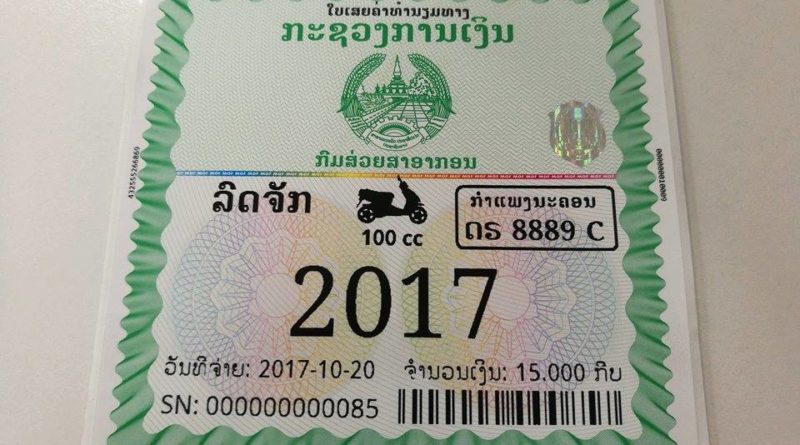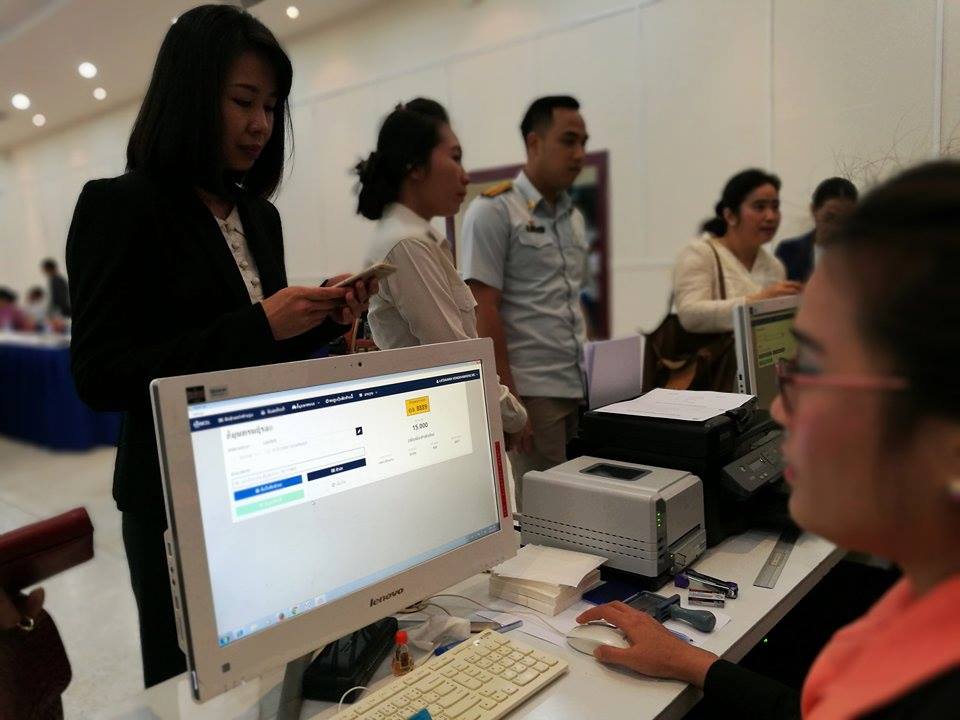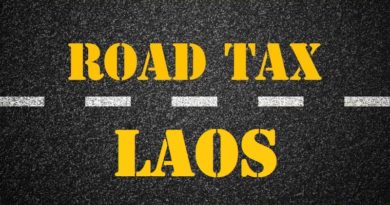Road Tax 2017 Now Due
Source: Vientiane Times
Summary:
– 2017 Road Tax now due for payment
– Available at BCEL bank only
– Valid from October this year until March 2018
Road users are now being asked to pay the road tax for 2017 after delays in making changes to the payment system have extended almost to the end of the year.
This year, the Ministry of Finance has authorised the Banque pour le Commerce Exterieur Lao Public (BCEL) to collect the road tax, with the payment date officially starting last Thursday.
Deputy Director General of the Tax Department, Mr Khampien Boupphavong, told Vientiane Times on Friday “Tax collection has now commenced and tax stickers for display on windscreens can be received at BCEL only.”
The bank has developed a special system to make payment easy. People can pay through BCEL One Apps on computers or smartphones, at an ATM, or by walking into a bank.
A BCEL employee said the use of the BCEL One and ATM services was very convenient.
In the past the tax authorities have partnered with the bank to offer new options for other tax payments such as VAT.
Some people are concerned about obtaining a tax sticker if they make payments through BCEL One or an ATM.
Bank staff explained that when using BCEL One, the system will show a code. The user can snap it on their mobile phone or computer or take note of the number, and then show it with the yellow technical inspection book and vehicle document to bank clerks. You will then receive the sticker on the spot so you don’t have to spend a lot of time waiting at the bank.
Using an ATM is equally simple as it prints out a code which vehicle owners can take along with the necessary documents to present to bank staff.
If you prefer not to use either of these methods, payment can be made directly at the bank.
Mr Khampien is optimistic about the new system and believes that the use of modern technology will make payments more transparent and the procedure easier to check.
Some people are concerned that this payment system will not be accessible to vehicle owners who live in rural areas or outside city centres, but the tax official said the bank has its methods of collecting the tax from these people.
The tax authorities expect that receipts will amount to 30 billion kip in 2017, up from 10 billion kip last year.
To reach the target, the tax sector plans to discuss various measures with the police and public works and transport sector. These two bodies are critical to motivating owners to pay the necessary taxes.
Mr Khampien said he was not concerned about the new system and hoped that it would help to boost revenue collection.
The 2017 tax sticker is valid from October this year until March 2018. The tax will then be due again next year.
In previous years, vehicle owners began paying the tax in March, but this year the process was delayed for many months while the Ministry of Finance waited for the new Presidential Decree on Road Tax.
The decree, which was signed by President Bounnhang Vorachit on September 20, has significantly increased the annual road tax.
The new Presidential Decree on Road Tax has determined the new annual fees and divided them into four vehicle groups.
The first group comprises two- and three-wheeled motorbikes. A motorbike with an engine less than 110cc will incur a fee of 15,000 kip, up from 8,000 kip in previous years. It will be 20,000 kip for a motorbike with a 111 to 150cc engine, 30,000 kip for a 151 to 200cc motorbike, and 100,000 kip for motorbikes over 200cc.
The second group comprises privately-owned sedans, SUVs, vans and pickups. For vehicles with an engine less than 1,000cc the fee is 100,000 kip; 150,000 kip for vehicles with engines between 1,001 to 1,600cc; 200,000 kip for engines 1,601 to 2,000cc; 250,000 kip for 2,001 to 2,500cc; 300,000 kip for 2,501 to 3,000cc; 350,000 kip for 3,001cc to 4,000cc; 400,000 kip for 4,001 to 5,000cc; and 500,000 kip for vehicles with engines over 5,001cc.
The third group is transport vehicles. For a small truck with an engine less than 2,500cc or a total weight less than 3.5 tonnes the owner will pay 150,000 kip; 200,000 kip for medium trucks with engines of 2,501 to 5,000cc or total weight between 3.5 and 15 tonnes; 300,000 kip for large sized trucks with engines over 5,000cc and total weight between 15 and 30 tonnes; 400,000 kip for large sized trucks with engines over 5,000cc and total weight between 30 and 50 tonnes; and 500,000 kip for large sized trucks with engines over 5,000cc and total weight over 50 tonnes.
The fourth category is passenger vehicles. The owners of three-wheeled tuk-tuks and jumbos vehicles will pay 50,000 kip; 150,000 kip for small vans or passenger vehicles with engines up to 2,500cc with less than nine seats including the driver’s seat; 200,000 kip for medium-sized vans and buses between 2,500 to 5,000cc or between 10 to 35 seats including the driver’s seat; and 400,000 kip for large buses with engines over 5,000cc or more than 35 seats.
According to statistics from the Tax Department, Laos has about 1.8 million vehicles, but only about 30 percent of vehicle owners actually pay road tax each year.




